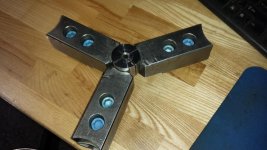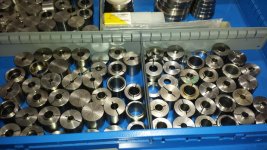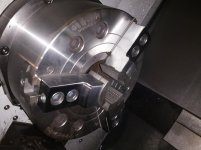After 20+ years of owning my own shop, I feel like a complete NooB asking this, but truly, I don't know.
asking this, but truly, I don't know.
How are you supposed to use (or true up) the points on a new set of steel soft jaws, for small diameter chucking?
1) My lathe chucks are Kitagawa B208 or B210's with 1.5mm x 60° serrations.
2) 90% of the soft jaws I purchase are 2 - 2.5" tall, flat ended, steel, offset, soft jaws.
3) We always chuck on something when we bore our jaws: jaw boring rings, jaw boring plates, cheek plates (in between the 120° mating surfaces of the 3 jaws, when closed) and slugs/ pins of material
4) Purchased jaws w/ pointed ends are not a good surface to chuck with, and need to be machined, to spin small diameter material concentric to the spindle.
Question:
How does one true up the points, say for holding Ø3/8" or Ø1/2" ??
Running a long endmill right down the center, does not yield a good gripping surface. It is also way too deep & too small of a diameter to follow with a boring bar. (the L/D ratio would be 7/1)
I can think of making a mill fixture to hold the jaws with the serrations, and then mill a radius (a flat, or the part shape) into the jaws,
OR
Dismounting the chuck from the lathe, and milling the jaws when installed on the lathe chuck.
the chuck from the lathe, and milling the jaws when installed on the lathe chuck. This approach seems like a LOT of unnecessary work.
This approach seems like a LOT of unnecessary work.
So, what am I missing????
Thanks,
Doug.
 asking this, but truly, I don't know.
asking this, but truly, I don't know.How are you supposed to use (or true up) the points on a new set of steel soft jaws, for small diameter chucking?
1) My lathe chucks are Kitagawa B208 or B210's with 1.5mm x 60° serrations.
2) 90% of the soft jaws I purchase are 2 - 2.5" tall, flat ended, steel, offset, soft jaws.
3) We always chuck on something when we bore our jaws: jaw boring rings, jaw boring plates, cheek plates (in between the 120° mating surfaces of the 3 jaws, when closed) and slugs/ pins of material
4) Purchased jaws w/ pointed ends are not a good surface to chuck with, and need to be machined, to spin small diameter material concentric to the spindle.
Question:
How does one true up the points, say for holding Ø3/8" or Ø1/2" ??
Running a long endmill right down the center, does not yield a good gripping surface. It is also way too deep & too small of a diameter to follow with a boring bar. (the L/D ratio would be 7/1)
I can think of making a mill fixture to hold the jaws with the serrations, and then mill a radius (a flat, or the part shape) into the jaws,
OR
Dismounting
 the chuck from the lathe, and milling the jaws when installed on the lathe chuck.
the chuck from the lathe, and milling the jaws when installed on the lathe chuck. This approach seems like a LOT of unnecessary work.
This approach seems like a LOT of unnecessary work.So, what am I missing????
Thanks,
Doug.









